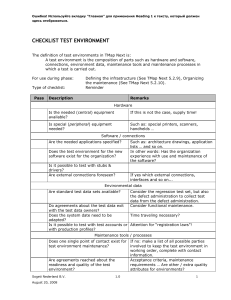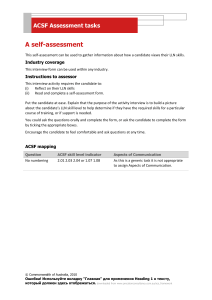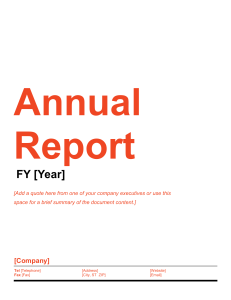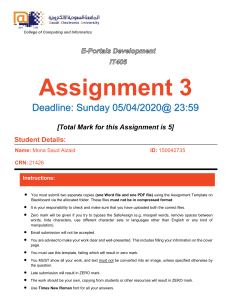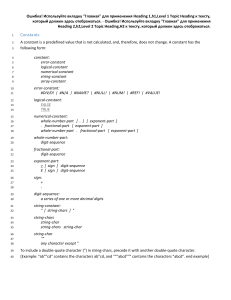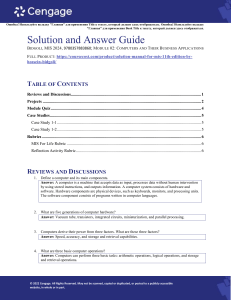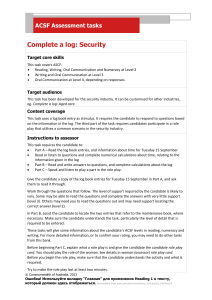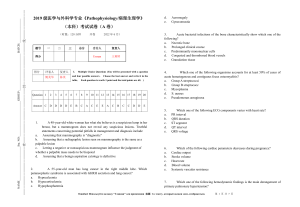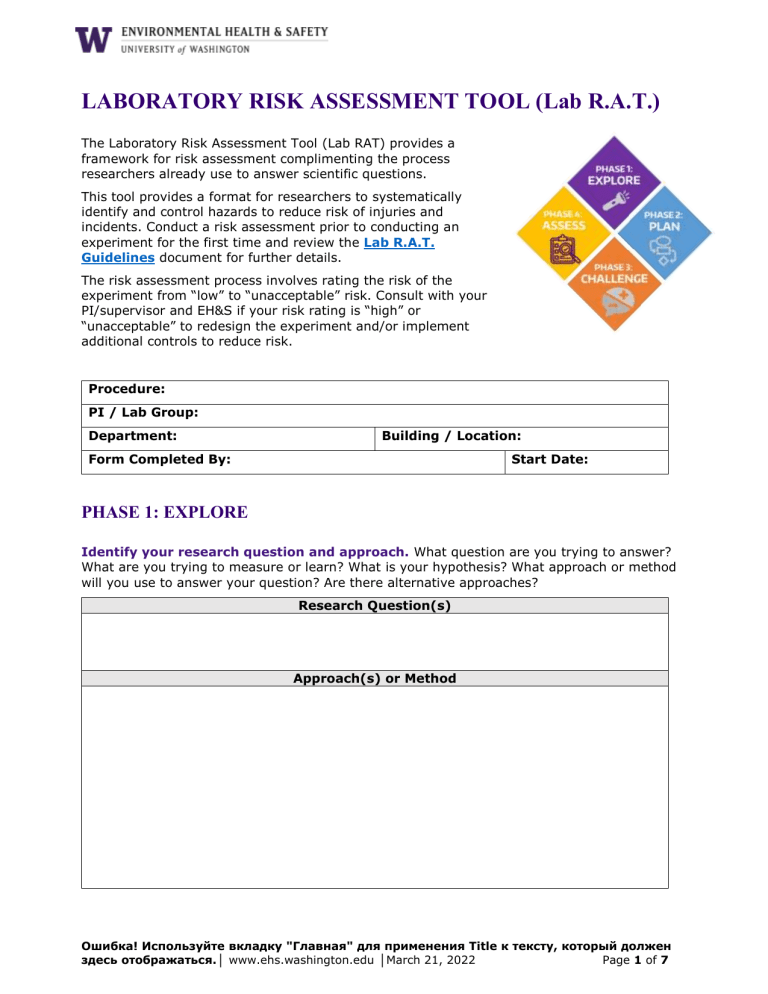
LABORATORY RISK ASSESSMENT TOOL (Lab R.A.T.) The Laboratory Risk Assessment Tool (Lab RAT) provides a framework for risk assessment complimenting the process researchers already use to answer scientific questions. This tool provides a format for researchers to systematically identify and control hazards to reduce risk of injuries and incidents. Conduct a risk assessment prior to conducting an experiment for the first time and review the Lab R.A.T. Guidelines document for further details. The risk assessment process involves rating the risk of the experiment from “low” to “unacceptable” risk. Consult with your PI/supervisor and EH&S if your risk rating is “high” or “unacceptable” to redesign the experiment and/or implement additional controls to reduce risk. Procedure: PI / Lab Group: Department: Building / Location: Form Completed By: Start Date: PHASE 1: EXPLORE Identify your research question and approach. What question are you trying to answer? What are you trying to measure or learn? What is your hypothesis? What approach or method will you use to answer your question? Are there alternative approaches? Research Question(s) Approach(s) or Method Ошибка! Используйте вкладку "Главная" для применения Title к тексту, который должен здесь отображаться.│ www.ehs.washington.edu │March 21, 2022 Page 1 of 7 Identify the general hazards (check all that apply). Perform background research to identify known risks of the reagents, reactions, or processes. Review protocols, Safety Data Sheets (SDSs), and safety information for hazardous chemicals, agents, or processes. Review accident histories within your laboratory/department. Hazardous Agents Physical Hazards of Chemicals ☐ Compressed gases Health Hazards of Chemicals ☐ Acute toxicity Ionizing Radiation ☐ Irradiator ☐ Cryogens ☐ Carcinogens ☐ Explosives ☐ Eye damage/ irritation ☐ Radionuclide sealed source ☐ Flammables ☐ Organic peroxides ☐ Oxidizers ☐ Peroxide formers ☐ Pyrophorics ☐ Self-heating substances ☐ Germ cell mutagens ☐ Nanomaterials ☐ Reproductive toxins ☐ Respiratory or skin sensitization ☐ Simple asphyxiant ☐ Self-reactive substances ☐ Skin corrosion/ irritation ☐ Substances which, in contact with water, emit flammable or toxic gases ☐ Hazards not otherwise classified ☐ Specific target organ toxicity ☐ Radionuclide Biohazards ☐ BSL-2 Biological agents ☐ BSL-3 Biological agents ☐ X-ray machine ☐ Human cells/blood/ BBP Non-Ionizing Radiation ☐ Lasers, Class 3 or 4 ☐ NHPs/cells/blood ☐ Lasers, Class 2 ☐ Magnetic fields (e.g., NMR, MRI) ☐ RF/microwaves ☐ Non-exempt rDNA ☐ Animal work ☐ High risk animals (RC1) ☐ Other (list): ☐ UV lamps Hazardous Conditions or Processes Reaction Hazards ☐ Explosive ☐ Exothermic, with potential for fire, excessive heat, or runaway reaction ☐ Endothermic, with potential for freezing solvents decreased solubility or heterogeneous mixtures ☐ Gases produced ☐ Hazardous reaction intermediates/products Hazardous Processes ☐ Generation of air contaminants (gases, aerosols, or particulates) ☐ Heating chemicals ☐ Large mass or volume ☐ Pressure > atmospheric ☐ Pressure < atmospheric ☐ Scale-up of reaction Other Hazards ☐ Hand/power tools ☐ Moving equipment/parts ☐ Electrical ☐ Noise > 80 dBA ☐ Heat/hot surfaces ☐ Ergonomic hazards ☐ Needles/sharps ☐ Other (list): ☐ Hazardous side reactions Ошибка! Используйте вкладку "Главная" для применения Title к тексту, который должен здесь отображаться.│ www.ehs.washington.edu │March 21, 2022 Page 2 of 7 PHASE 2: PLAN Outline the Procedure. List the steps or tasks for your procedure and the hazard/potential consequences of each. Include set-up and clean-up steps or tasks. Define the hazard controls to minimize the risk of each step using the hierarchy of controls starting with the most effective (i.e., elimination, substitution, engineering controls, administrative controls, and personal protective equipment). List the hazard control measure you would use for each step or task (e.g., run at a micro scale, work in a fume hood, wear face shield and goggles). Steps or Tasks Hazard Hazard Control Measure(s) Eliminate use of chemical or hazard Use a less hazardous chemical, concentration, or process Isolate people from hazard (e.g. ventilation, barriers) Change the way people work (e.g. training, work policies, SOPs) Personal protective equipment (e.g. lab coat, appropriate gloves, goggles) 1 For guidance on selection of Personal Protective Equipment (PPE), use EH&S PPE Hazard Assessment Tool. 2 For guidance on selection of chemical-resistant gloves, see EH&S Website. A hierarchy of controls should be applied starting with the most effective controls (i.e., elimination and substitution) at the top of the graphic and moving down. While personal protective equipment (PPE) should always be used, it should be considered the last line of defense from potential hazards. Ошибка! Используйте вкладку "Главная" для применения Title к тексту, который должен здесь отображаться.│ www.ehs.washington.edu │March 21, 2022 Page 3 of 7 Select the appropriate PPE and safety supplies for the procedure (check all that apply). Laboratory PPE/Safety Supplies ☒ Appropriate street clothing ☐ First aid kit (long pants, closed shoes) ☐ Spill kit ☐ Gloves; indicate type: ________________________ ☐ Safety glasses ☐ Specialized medical supplies (e.g. calcium gluconate for hydrofluoric acid and amyl nitrite for cyanides ☐ Safety goggles ☐ Other (list): ☐ Face shield and googles ☐ Lab coat ☐ Flame-resistant lab coat ☐ Fire extinguisher ☐ Eyewash/safety shower Identify the appropriate training (check all that apply). Identify the general safety and procedure based/specific training appropriate for your procedure. General Safety Training General/Chemical Safety ☐ Lab Safety Compliance & Practices Biosafety ☐ Biosafety Training Field Safety ☐ First Aid & CPR ☐ Bloodborne Pathogens ☒ Managing Lab Chemicals ☐ SCUBA certification/diving safety ☐ Compressed Gas Safety Radiation Safety ☐ Radiation Safety ☐ Driving safety ☐ Fume Hood Training ☐ Laser Safety ☐ Other (list): ☐ Hydrofluoric Acid Safety ☐ Formaldehyde Safety Job Specific Training ☒ Lab/job-specific training ☐ Lab SOP(s) to review (list): ☐ Emergency plans or field evacuation plans ☐ Other (list): ☐ Equipment SOP(s) to review (list): Ошибка! Используйте вкладку "Главная" для применения Title к тексту, который должен здесь отображаться.│ www.ehs.washington.edu │March 21, 2022 Page 4 of 7 PHASE 3: CHALLENGE Question your methods. What have you missed and who can advise you? Challenge your hazard control measures by asking “What if…?” questions. “What if” questions should challenge you to find the gaps in your knowledge or logic. Include possible accident scenarios. Factors to consider are human error, equipment failures, and deviations from the planned/expected parameters (e.g., temperature, pressure, time, flow rate, and scale/concentration). Update your plan to include any new controls required to address these possibilities. What If Analysis What if…? Examples: there is a loss of cooling? …valves/stopcocks are left open/closed? …there is unexpected over-pressurization? …a spill occurs? …the laser is misaligned? …weather conditions change? Then… there may be a runaway reaction. …there may be an unexpected splash potential. …the reaction vessel may fail. …there may be a dermal exposure. …there may be an eye injury. …routes may be inaccessible. What if…? Then… What if…? Then… What if…? Then… What if…? Then… What if…? Then… What if…? Then… What if…? Then… Assign a risk rating to the experiment. Based on your procedure outline and the what if analysis, determine the risk rating for the experiment or procedure. Ошибка! Используйте вкладку "Главная" для применения Title к тексту, который должен здесь отображаться.│ www.ehs.washington.edu │March 21, 2022 Page 5 of 7 Risk Rating: ____________________ 1The Risk Rating is subjective. The primary goal is for researchers to think about risk, and differentiate unacceptable and high-level risk steps from those with a lower level risk. This will help drive additional consultation and control measures where needed. Revise plan if the risk rating is too high. Are these risks acceptable? Use this table to determine the action to take based on the risk rating. What are the highest risk steps? What more can you do to control the risks? Return to planning and use the hierarchy of controls to design a safer experiment. PI/Supervisor Approval: __________________________________ ______________________ *Signature for High risk ratings. If needed, contact EH&S (206.221.2339) for recommendations. NOTE: **Unacceptable risk-rated experiments should not proceed. Introduce further controls to reduce risk. Contact EH&S (206.221.2339) for recommendations and best practices. PHASE 4: ASSESS Perform a trial run. How you can test your experimental design? Can you do a dry run of the procedure without hazardous chemicals/reagents/gases to familiarize yourself with equipment and demonstrate your ability to manipulate the experimental apparatus? Can you run the procedure with a less hazardous material? Can you test your experimental design at a smaller scale? If your procedure requires multiple people, would a table top exercise be useful? Trial Run Trial Run Procedure / Date: Did the trial go as expected? Yes ☐ No ☐ Experimental design changes needed (if any): Ошибка! Используйте вкладку "Главная" для применения Title к тексту, который должен здесь отображаться.│ www.ehs.washington.edu │March 21, 2022 Page 6 of 7 Perform and evaluate. Run your procedure using the appropriate controls you’ve identified. Evaluate controls and hazards as you work. Critique the controls and process you used by answering the following questions. If changes to controls are needed, update your risk assessment tool and re-evaluate any time you revise your process (e.g. changes in scale, reagent, equipment, or conditions that might increase the hazard/risk). Share your assessment with your PI/colleagues for the next iteration of the experiment. Evaluate Your Procedure What went well? Did the controls perform as expected? Did anything unexpected occur? Did a hazard manifest itself that was not previously identified? Were there any close-calls or near misses that indicate areas of needed improvement? Did something go exceptionally well that others could learn from? I plan to evolve my procedure by... Procedure Risk Assessment is Complete Form Completed By: Signature: Date: PI / Supervisor Signature: Ошибка! Используйте вкладку "Главная" для применения Title к тексту, который должен здесь отображаться.│ www.ehs.washington.edu │March 21, 2022 Page 7 of 7


